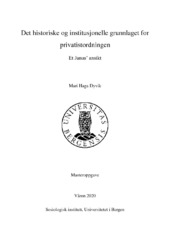| dc.contributor.author | Dyvik, Mari Haga | |
| dc.date.accessioned | 2020-06-27T04:28:00Z | |
| dc.date.available | 2020-06-27T04:28:00Z | |
| dc.date.issued | 2020-06-27 | |
| dc.date.submitted | 2020-06-26T22:00:37Z | |
| dc.identifier.uri | https://hdl.handle.net/1956/23083 | |
| dc.description.abstract | Dette prosjektet har dreid seg om å utforske privatistordningen som en institusjon. Bakgrunnen for dette er at bruken av privatistordningen har vokst slik i omfang at den nå utgjør en betydelig del av utdanningssystemet. Privatistordningen er en gammel institusjon i Norge, som er det eneste landet som har denne praksisen innenfor videregående skole. Privatistordningen har i liten grad blitt undersøkt sosiologisk. Hensikten med prosjektet har vært å få en forståelse hva som er det historiske og institusjonelle grunnlaget for dagens privatistordning. Hva har vært intensjonen med ordningen, hvilken funksjon har det vært meningen at privatistordningen skulle ha, og hvordan har dette vært begrunnet? Hvilke aktører og interesser har fått forme institusjonen og hvilke hensyn har fått veie inn? Dette er en kvalitativ casestudie med et komparativt element der ulike deler av privatistordningens utvikling undersøkes i dybden og sees opp mot hverandre. Det teoretiske rammeverket er knyttet til historisk-institusjonalisme og maktressursteori. Det empiriske materialet består av dokumenter blant annet fra Stortingets arkiv, og ekspertintervju av fem personer som gjennom sin posisjon har fått innsikt som har kunnet belyst mine forskningsspørsmål. Resultatet er fortolket ut fra fakta og dokumentasjon, sett i lys av de teoretiske rammene jeg har funnet fruktbare. Privatistordningens rolle kan beskrives som todelt, både historisk og i dag. På den ene siden tjener privatistordningen som en velferdsordning som kan bøte for noe livsløpsrisiko og ande sosiale ulikheter. På den andre siden tjener ordningen best dem som allerede lykkes i utdanningssystemet og som er i en økonomisk privilegert situasjon. Jeg beskriver denne tosidigheten som institusjonens Janus’ ansikt. At så mange forbedrer karakterer fra videregående skole gjør det nødvendig å undersøke om det fører til mindre eller økte sosiale forskjeller. | en_US |
| dc.description.abstract | This project has examined the External Candidate Exam as an institution. The External Candidate Arrangement has become a significant part of the education system, as the the number of people using the Arrangement to improve their credits has increased. The institution has long historical roots in Norway, which is the only country that has this praxis within the upper secondary school system. The External Candidate Arrangement has not been explored sociologically. This is something I wish to contribute to with this theis. The aim has been to understand the historical and institutions foundations for the External Candidate Exam. The projects research questions aks: what has been the intention behind the Arrangement, what has been the intende function, and how has this been argued? Which actors and interests has been allowed to shape the institution, and which considerations has influenced decisions? This is a single case study with a comparative element in that it uses within-case metods. Different parts of the history of the institution has been explored and compared. The main theories guiding the analysis is Historical- Institutionalism and Power Resource Theory. The empirical material is documents, such reports and more, from the Parliament. As well as expert/elite interviews. The results from my analysis is interpreted based on facts and documentation, and according to the theoretical perspectives from Historical-institutionalism and Power Resource Theory. The External Candidate Exam plays a role that can be described as dual. On one hand it plays the part on a welfare arrangement that prevents unequal access to education and life chances. On the other hand, the arrangement works best for those who are already succeeding in using the education system to their advantage, and that are in a privileged economic position. I describe this dual role as the institutions’ Janus’ face. As more and more people retake high school exams as private candidates, it had to be explored whether this increase or decrease equality. | en_US |
| dc.language.iso | nob | |
| dc.publisher | The University of Bergen | |
| dc.rights | Copyright the Author. All rights reserved | |
| dc.subject | privatisteksamen | |
| dc.subject | Privatistordningen | |
| dc.subject | eliteintervju | |
| dc.subject | historisk-institusjonalisme | |
| dc.subject | maktressursteori | |
| dc.subject | ekspertintervju | |
| dc.title | Det historiske og institusjonelle grunnlaget for privatistordningen: et Janus' ansikt | |
| dc.title.alternative | The External Candidate Exam in the Norwegain Upper Secondary Education System: an Institution with a Janus' face. | |
| dc.type | Master thesis | en_US |
| dc.date.updated | 2020-06-26T22:00:37Z | |
| dc.rights.holder | Copyright the Author. All rights reserved | en_US |
| dc.description.localcode | SOS360 | |
| dc.description.localcode | MASV-SOS | |
| dc.subject.nus | 732106 | |
| fs.subjectcode | SOS360 | |
| fs.unitcode | 15-11-0 | |
